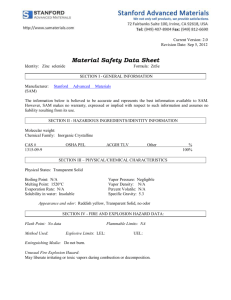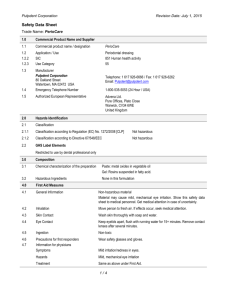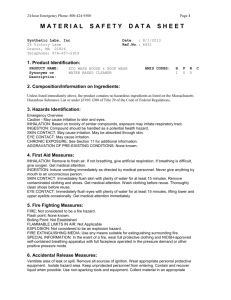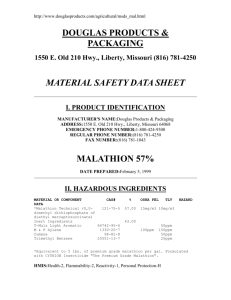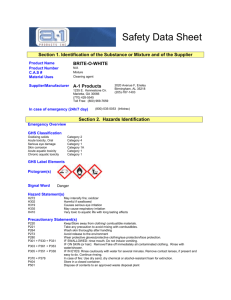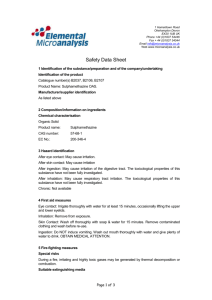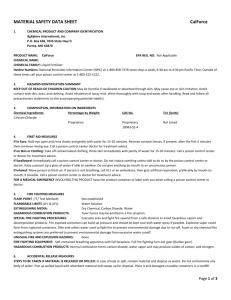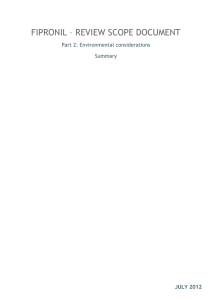MSDS DAVID Gel (Eng)
advertisement
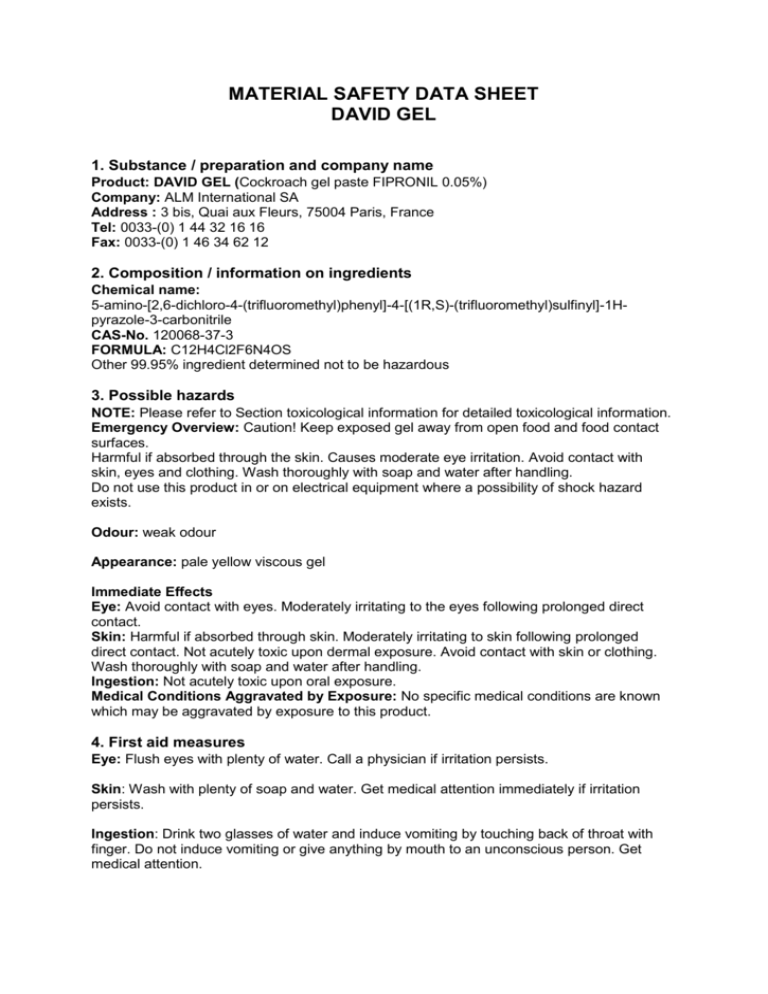
MATERIAL SAFETY DATA SHEET DAVID GEL 1. Substance / preparation and company name Product: DAVID GEL (Cockroach gel paste FIPRONIL 0.05%) Company: ALM International SA Address : 3 bis, Quai aux Fleurs, 75004 Paris, France Tel: 0033-(0) 1 44 32 16 16 Fax: 0033-(0) 1 46 34 62 12 2. Composition / information on ingredients Chemical name: 5-amino-[2,6-dichloro-4-(trifluoromethyl)phenyl]-4-[(1R,S)-(trifluoromethyl)sulfinyl]-1Hpyrazole-3-carbonitrile CAS-No. 120068-37-3 FORMULA: C12H4Cl2F6N4OS Other 99.95% ingredient determined not to be hazardous 3. Possible hazards NOTE: Please refer to Section toxicological information for detailed toxicological information. Emergency Overview: Caution! Keep exposed gel away from open food and food contact surfaces. Harmful if absorbed through the skin. Causes moderate eye irritation. Avoid contact with skin, eyes and clothing. Wash thoroughly with soap and water after handling. Do not use this product in or on electrical equipment where a possibility of shock hazard exists. Odour: weak odour Appearance: pale yellow viscous gel Immediate Effects Eye: Avoid contact with eyes. Moderately irritating to the eyes following prolonged direct contact. Skin: Harmful if absorbed through skin. Moderately irritating to skin following prolonged direct contact. Not acutely toxic upon dermal exposure. Avoid contact with skin or clothing. Wash thoroughly with soap and water after handling. Ingestion: Not acutely toxic upon oral exposure. Medical Conditions Aggravated by Exposure: No specific medical conditions are known which may be aggravated by exposure to this product. 4. First aid measures Eye: Flush eyes with plenty of water. Call a physician if irritation persists. Skin: Wash with plenty of soap and water. Get medical attention immediately if irritation persists. Ingestion: Drink two glasses of water and induce vomiting by touching back of throat with finger. Do not induce vomiting or give anything by mouth to an unconscious person. Get medical attention. Notes to physician Signs and Symptoms: Effects resulting from over-exposure are not anticipated to occur from use of the bait gel. In severe cases of overexposure to Fipronil itself (the active ingredient) by oral ingestion, lethargy, muscle tremors, and in extreme cases, possibly convulsions may occur. Treatment: There is no specific antidote. TREATMENT FOR FlPRONIL OVERDOSE: Recommendations for treatment are based on anticonvulsant therapy as routinely administered to humans. Phenobarbital or diazepam may be useful in controlling convulsions induced by Fipronil. Even when symptoms of Fipronil intoxication are rapidly reversed by treatment, the treatment must be continued for several days, gradually decreasing the dose of anticonvulsant based on the patient’s clinical response. This is necessary due to the slow elimination of the compound. 5. Fire fighting measures Flash Point: Not flammable or explosive Fire and Explosion Hazards:Under fire conditions, toxic, corrosive fumes may be emitted of the active ingredient, Fipronil. Suitable Extinguishing Media:Dry chemical, Foam, Water, Carbon dioxide (C02) Fire Fighting Instructions: Move container from fire area if you can do it without risk. Do not scatter spilled material with high-pressure water streams. Avoid breathing vapours, keep upwind. Positive pressure self-contained breathing apparatus with full face piece and structural fire fighters’ protective clothing will provide limited protection. 6. Accidental release measures General and Disposal Wear appropriate gear for the situation. See Personal Protection information in Section 8. Land Spill or Leaks: If spilled on the ground; the affected area should be scraped clean and placed in an appropriate container for disposal. Decontaminate tools and equipment following cleanup. 7. Handling and storage Handling Procedures: Keep exposed gel away from open food and food contact surfaces. Do not treat food preparation surfaces. Do not ingest. Storing Procedures: Store in a cool, dry area. Keep out of reach of children and domestic animals. Keep away from direct sunlight. Avoid excess heat. Work Hygienic Procedures: Do not store, use, and/or consume foods, beverages, tobacco products, or cosmetics in areas where this material is stored. Wash hands thoroughly with soap and water after handling and before eating, drinking, chewing gum, using tobacco, or using the toilet. Wash skin promptly to remove accidental contact with the active ingredient, Fipronil. Avoid contact with skin and clothing. Wash thoroughly with soap and water after handling. Remove contaminated clothing and launder before re-wearing. Wash clothing with detergent and hot water before reusing. Contaminated clothing should not be taken home or laundered with other clothing. 8. Exposure controls and personal protection Engineering Controls: Use general ventilation to minimize exposure. Body Protection: Chemical-resistant gloves made of waterproof material such as neoprene, butyl rubber, barrier laminate or nitrile rubber. Skin contact should be prevented through use of suitable protective clothing, gloves and footwear, selected with regard of use conditions and exposure potential. General Protection: These recommendations provide general guidance for handling this product. Because specific work environments and material handling practices vary, safety procedures should be developed for each intended application. Waste resulting from these procedures should be handled in accordance with Section 13: Disposal Considerations. Assistance with selection, use and maintenance of worker protection equipment is generally available from equipment manufacturers. Exposure Limits: None Established 9. Physical and chemical properties Odour: weak odour Appearance: pale yellow viscous gel 10. Stability and reactivity Reactivity: Stable under normal temperatures and pressures Conditions to Avoid: Avoid excessive heat >180 deg. C (>356 deg. F). Incompatibility: Avoid contact with strong acids (pH <2) and bases (pH >10) Hazardous Decomposition: Decomposition may release carbon monoxide, carbon dioxide, nitrogen oxide, and iodine vapours. Hazardous Polymerization: Hazardous polymerization does not occur. Chemical Stability: Fipronil is stable under normal handling and storage conditions. Conditions to Avoid: Direct sunlight Exposure to extreme heat Product will stain porous surfaces. Incompatibility: Strong acids and strong bases Strong oxidizing agents Hazardous Products of Decomposition: Decomposition Type: thermal Hydrogen fluoride Oxides of nitrogen Oxides of sulfur Carbon oxides Hydrochloric acid Hazardous Polymerization (Conditions to avoid): Will not occur 11. Toxicological information NOTE: Data for the acute information is based on studies performed on active Fipronil. Acute Oral Toxicity: Rat: LD5O: > 5,000 mg/kg Acute Dermal Toxicity: LD5O: > 2,000 mg/kg Acute Inhalation Toxicity: Rat: LC5O: > 1000mg/I Skin Irritation: Rabbit: Slightly irritating. Eye Irritation: Rabbit: Non-irritating. Sensitization: Guinea pig: Non-sensitizing Assessment Carcinogenicity ACGIH: None NTP: None IARC:None OSHA:None 12. Ecological information The following data is based on the technical grade active ingredient(s). Acute and Prolonged Toxicity to Fish: Rainbow trout flow-through test LC5O: 0.248 mg/I Exposure Time: 96 h. Mean concentration. Bluegill sunfish flow-through test LC5O: 0.085 mg/I Exposure Time: 96 h Mean concentration. Acute Toxicity to Aquatic Invertebrates Daphnia flow-through test EC5O: 0.248 mg/I Exposure Limit: 48 h Mean concentration. Toxicity Other Non Mammal Terr. Species Mallard duck LC5O: > 5,000 mg/kg Exposure Time: 8 d Dietary concentrations. Mean concentration. Bobwhite quail LC5O: 48 mg/kg Exposure Time: 8 d Dietary concentrations. Mean concentration. Environmental Precautions Toxic to birds, fish and aquatic invertebrates. Do not apply directly to water, to areas where surface water is present or to intertidal areas below the mean high water mark. Do not contaminate surface or ground water by cleaning equipment or disposal of wastes. Contain runoff to prevent entry into sewers or waterways. 13. Disposal considerations Must be disposed of by special means, e.g. suitable incineration, in accordance with local regulations. Contaminated packaging: Contaminated packs should be emptied as far as possible, they can then be passed on for recycling after being thoroughly cleaned. 14. TRANSPORTATION CLASSIFICATION Not Regulated for Transportation. 15. Other Information The information contained herein is based on the present state of our knowledge and does not therefore guarantee certain properties. Recipients of our product must take responsibility for observing existing laws and regulations.

